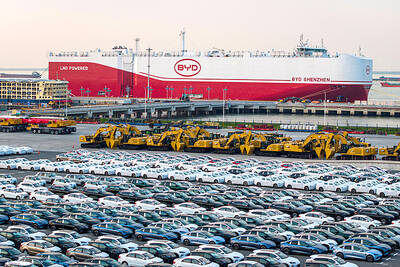It seems that fake paper money is no longer good enough for the dead of Taiwan, where relatives traditionally burn make-believe cash to help ease the passage of their deceased loved ones through the byways of the netherworld.
Instead, many people now opt to provide ancestral ghosts with more elaborate paper gifts — models of everything from Ferraris to iPhones and even villas.
Many Taiwanese believe that burning a paper model makes a version of the item available to the dead in the spirit world. For centuries, fake money was the primary gift for the dead. The first week after someone died was reserved for burning thick wads of yellow-colored paper cash.
Recently, Taiwanese have increasingly turned to sophisticated paper models. They reflect a new desire to ensure that the dearly departed take with them what they need, rather than what may be useless wads of bills in a place where buying opportunities have never been convincingly documented.
Taiwanese firms making the new-style paper gifts report booming business ahead of Monday’s Tomb-Sweeping Day, when millions of people across Asia pay respects to their ancestors and dead relatives.
The Sky-Home Shop (天國之屋) — one of several shops advertised on the Internet — looks like an up-market salon for billionaires, but its prices are within reach of many ordinary Taiwanese.
Pet houses, slot-machines, racing cars, villas and even private jets go for anywhere between NT$4,000 (US$125) and NT$25,000.
“Everything is handmade,” said Sky Home owner Huang Chih-kuo (黃志國).
“A car has a steering-wheel and seats that may be made of paper but actually look like genuine leather,” Huang said.
He said he takes special orders, including those for guns to allow weapons collectors or gangsters to continue their lifestyle as ghosts.
SKEA (天堂配件公司), another firm in the paper-gifts-for-the-dead business, got its start in 2007 after the widow of a sumo wrestling fan requested a paper sumo platform for her dead husband.
“We saw how the gift brought a smile to the aging widow who had been crying her heart out,” SKEA manager Frank Han said.
SKEA has begun making an S model of the iPhone, complete with USB charger. Han said the company also is marketing an elaborate paper communications center that is supposed to ensure that iPhone calls can make their way between the dead and living.

Micron Memory Taiwan Co (台灣美光), a subsidiary of US memorychip maker Micron Technology Inc, has been granted a NT$4.7 billion (US$149.5 million) subsidy under the Ministry of Economic Affairs A+ Corporate Innovation and R&D Enhancement program, the ministry said yesterday. The US memorychip maker’s program aims to back the development of high-performance and high-bandwidth memory chips with a total budget of NT$11.75 billion, the ministry said. Aside from the government funding, Micron is to inject the remaining investment of NT$7.06 billion as the company applied to participate the government’s Global Innovation Partnership Program to deepen technology cooperation, a ministry official told the

Taiwan Semiconductor Manufacturing Co (TSMC, 台積電), the world’s leading advanced chipmaker, officially began volume production of its 2-nanometer chips in the fourth quarter of this year, according to a recent update on the company’s Web site. The low-key announcement confirms that TSMC, the go-to chipmaker for artificial intelligence (AI) hardware providers Nvidia Corp and iPhone maker Apple Inc, met its original roadmap for the next-generation technology. Production is currently centered at Fab 22 in Kaohsiung, utilizing the company’s first-generation nanosheet transistor technology. The new architecture achieves “full-node strides in performance and power consumption,” TSMC said. The company described the 2nm process as

Shares in Taiwan closed at a new high yesterday, the first trading day of the new year, as contract chipmaker Taiwan Semiconductor Manufacturing Co (TSMC, 台積電) continued to break records amid an artificial intelligence (AI) boom, dealers said. The TAIEX closed up 386.21 points, or 1.33 percent, at 29,349.81, with turnover totaling NT$648.844 billion (US$20.65 billion). “Judging from a stronger Taiwan dollar against the US dollar, I think foreign institutional investors returned from the holidays and brought funds into the local market,” Concord Securities Co (康和證券) analyst Kerry Huang (黃志祺) said. “Foreign investors just rebuilt their positions with TSMC as their top target,

POTENTIAL demand: Tesla’s chance of reclaiming its leadership in EVs seems uncertain, but breakthrough in full self-driving could help boost sales, an analyst said Chinese auto giant BYD Co (比亞迪) is poised to surpass Tesla Inc as the world’s biggest electric vehicle (EV) company in annual sales. The two groups are expected to soon publish their final figures for this year, and based on sales data so far this year, there is almost no chance the US company led by CEO Elon Musk would retain its leadership position. As of the end of last month, BYD, which also produces hybrid vehicles, had sold 2.07 million EVs. Tesla, for its part, had sold 1.22 million by the end of September. Tesla’s September figures included a one-time boost in